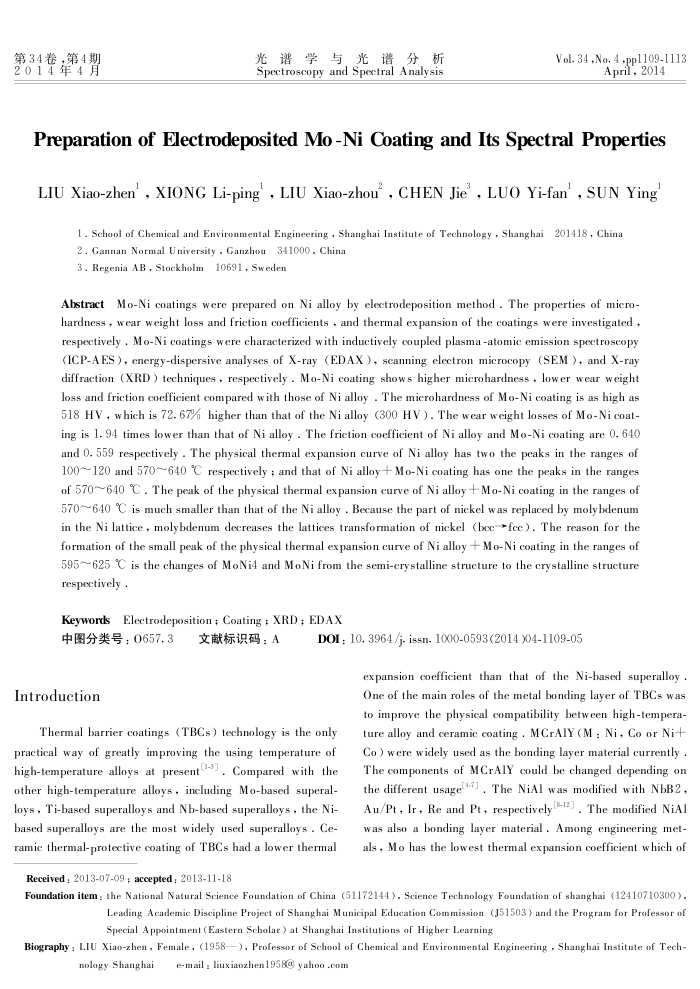您当前的位置:首页>论文资料>钼镍镀层的制备及其光谱性能
内容简介
 第34卷,第4期 2014年4月
第34卷,第4期 2014年4月光谱学与光谱分析 Spectroscopy and Spectral Analysis
Vol.34,No.4-ppl109-1113
April,2014
Preparation of Electrodeposited Mo -Ni Coating and Its Spectral Properties LIU Xiao-zhen', XIONG Li-ping', LIU Xiao-zhou', CHEN Jie", LUO Yi-fan', SUN Ying
1. School of Chemical and Environmental Engineering , Shanghai Institute of Technology , Shanghai201418, China
2. Gannan Normal University , Ganzhou 341000, China 3. Regenia AB, Stockholm10691, Sweden
Abstract Mo-Ni coatings were prepared on Ni alloy by electrodeposition method . The properties of micro-hardness , wear weight loss and friction coefficients , and thermal expansion of the coatings were investigated , respectively . Mo-Ni coatings were characterized with inductively coupled plasma-atomic emission spectroscopy(ICP-AES), energy-dispersive analyses of X-ray (EDAX ), scanning electron microcopy (SEM ), and X-ray diffraction (XRD ) techniques , respectively - Mo-Ni coating shows higher microhardness , lower wear weight loss and friction coefficient compared with those of Ni alloy . The microhardness of Mo-Ni coating is as high as 518 HV , which is 72. 67% higher than that of the Ni alloy (300 HV). The wear weight losses of Mo-Ni coat-ing is 1. 94 times lower than that of Ni alloy . The friction coefficient of Ni alloy and Mo-Ni coating are 0. 640 and 0. 559 respectively . The physical thermal expansion curve of Ni alloy has two the peaks in the ranges of 100~120 and 570~640 C respectively : and that of Ni alloy+ Mo-Ni coating has one the peaks in the ranges of 570~640 C . The peak of the physical thermal expansion curve of Ni alloy + Mo-Ni coating in the ranges of 570~640 C is much smaller than that of the Ni alloy . Because the part of nickel was replaced by molyhdenum in the Ni lattice , molybdenum decreases the lattices transformation of nickel (bcc→fcc ). The reason for the formation of the small peak of the physical thermal ex pansion curve of Ni alloy + Mo-Ni coating in the ranges of 595~625 °C is the changes of MoNi4 and MoNi from the semi-crystalline structure to the crystalline structure respectively .
KeywordsElectrodeposition ; Coating ; XRD ; EDAX
中图分类号:0657.3
Introduction
文献标识码:A
DOI;10. 3964/j. issn.1000-0593(2014)04-1109-05
expansion coefficient than that of the Ni-based superalloy -One of the main roles of the metal bonding layer of TBCs was to improve the physical compatibility between high-tempera-
Thermal barrier coatings (TBCs) technology is the only practical way of greatly improving the using temperature of high-temperature alloys at present(1-3] . Compared with the other high-temperature alloys , including Mo-based superal-loys , Ti-based superalloys and Nb-based superalloys , the Ni-based superalloys are the most widely used superalloys . Ce-ramic thermal-protective coating of TBCs had a lower thermal
Received : 2013-07-09 ; aceepted : 2013-11-18
ture alloy and ceramic coating . MCrAIY (M : Ni, Co or Ni+ Co ) were widely used as the bonding layer material currently The components of MCrAIY could be changed depending on the different usage-] , The NiAl was modified with NbB2, Au/Pt, Ir, Re and Pt, respectively[8-12] . The modified NiAl was also a bonding layer material . Among engineering met-als , Mo has the lowest thermal expansion coefficient which of
Foundation item : the National Natural Science Foundation of China (51172144 ), Science Technology Foundation of shanghai (12410710300 ),
Leading Academic Discipline Project of Shanghai Municipal Education Commission (J51503 ) and the Program for Professor of Special Appointment (Eastern Scholar ) at Shanghai Institutions of Higher Learning
Biography : LIU Xiao-zhen , Female , (1958—), Professor of School of Chemical and Environmental Engineering , Shanghai Institute of Tech-
nology Shanghai
e-mail : liuxiaozhen1958@ yahoo .com